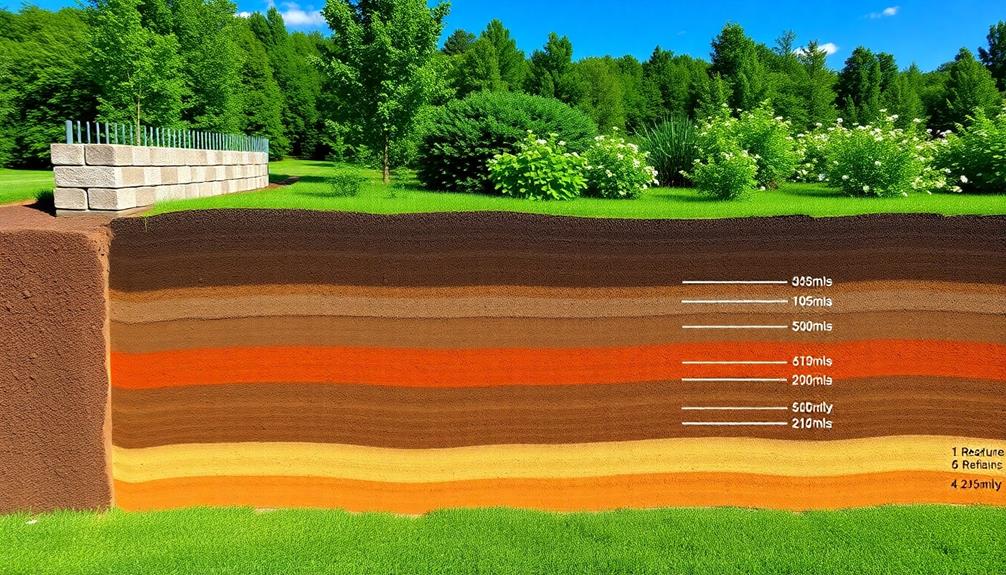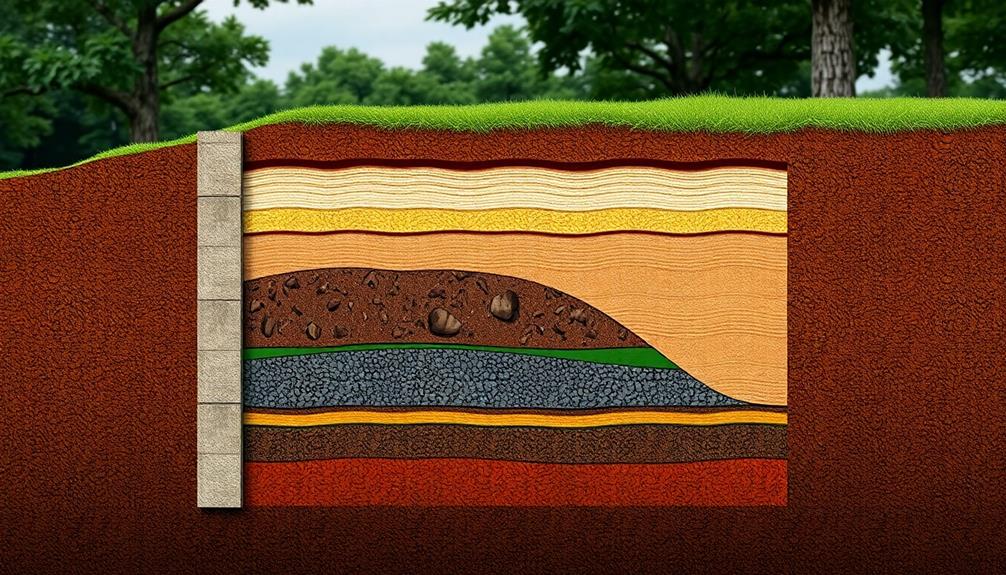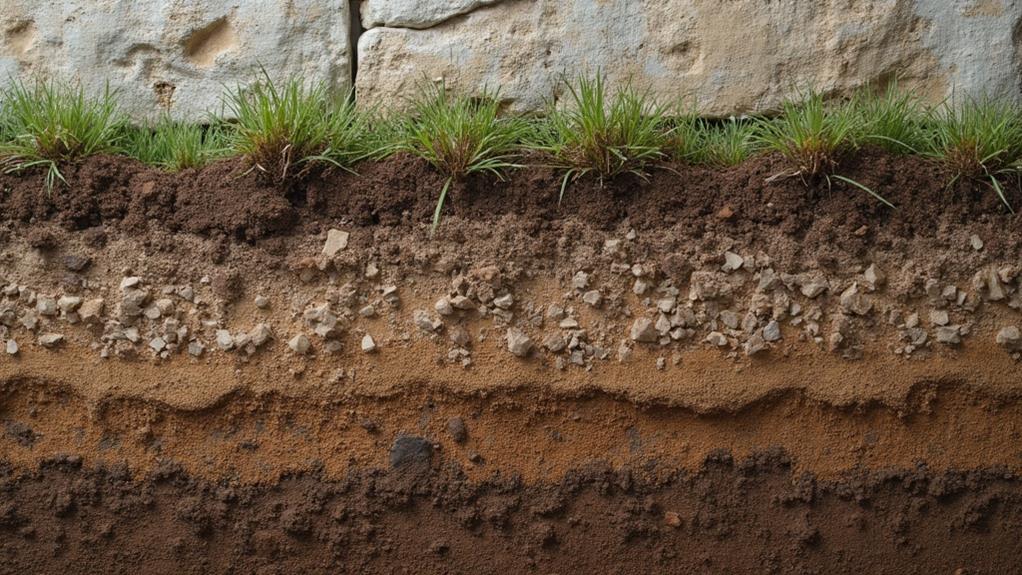To effectively analyze soil mechanics for retaining walls, a thorough evaluation of soil properties is essential, focusing on factors such as texture, moisture content, and compaction state. Understanding soil cohesion, friction angle, permeability, and strength, which are influenced by grain size distribution and water content, is pivotal for guaranteeing wall stability. Slope stability analysis evaluates soil shift potential using methods like limit equilibrium analysis, considering soil type, density, and external influences like surcharge loads. Additionally, appraising load-bearing capacity through tests like the Standard Proctor informs about soil's ability to support structures, integrating these aspects secures robust retaining wall designs. Further insights await.
Table of Contents
ToggleWalls Contractor Highlights
- Conduct soil classification for proper alignment of construction methods with site-specific conditions and retaining wall requirements.
- Measure soil properties like density, cohesion, friction angle, and permeability to assess retaining wall performance.
- Evaluate slope stability using methods like limit equilibrium analysis and factor in anthropogenic and environmental influences.
- Test soil load-bearing capacity using Standard Proctor and triaxial shear tests, incorporating external factors for accurate predictions.
- Consider frost line depth for foundation placement to prevent frost heaving and ensure the wall's longevity.
Soil Mechanics Analysis?

A thorough examination of soil mechanics is critical for ensuring the structural integrity of retaining walls, as it encompasses understanding the physical and chemical properties of the soil, which directly influence the wall's performance. By analyzing these properties, engineers can evaluate slope stability, a crucial aspect that determines the likelihood of soil movement and its impact on the wall's resilience under various conditions.
The choice of retaining wall materials can substantially affect how the wall interacts with the surrounding soil, making it an important consideration in the overall design process. Additionally, an assessment of the soil's load-bearing capacity is essential for ensuring the wall can withstand the pressures exerted by both the retained earth and any additional external forces, thereby preventing potential failures.
Understanding Soil Properties
Understanding soil properties is fundamental to the analysis of soil mechanics in the context of retaining walls. Each soil's unique characteristics, from texture to moisture content, play a pivotal role in determining how it will behave under the pressures exerted by retaining structures. Engineers and geotechnical experts meticulously study these properties, considering factors such as soil density, cohesion, friction angle, and permeability. The synergy of these factors dictates the stability and longevity of retaining wall systems, necessitating precise evaluation and understanding.
The intricate relationship between soil and retaining walls is underscored by the need for accurate soil classification. Such classification guarantees that the selection of construction techniques and materials aligns with the specific needs dictated by the soil conditions on site. The soil's ability to support structures hinges on its strength, which is influenced by grain size distribution, compaction state, and water content. This understanding extends beyond the theoretical, grounding its importance in real-world applications where safety and functionality are paramount.
In aiming to belong within the professional sphere of geotechnical analysis, comprehending soil properties is not merely beneficial; it is essential. Mastery over these elements leads to enhanced design processes, promoting safer and more efficient retaining wall structures.
Analyzing Slope Stability
Building on the foundation of understanding soil properties, analyzing slope stability becomes a central aspect of soil mechanics. This process involves evaluating the potential for soil to shift or collapse under various conditions, which is indispensable for the design and construction of retaining walls. Engineers focus on the interplay between gravitational forces, soil cohesion, and friction angles to assess stability, employing methodologies such as limit equilibrium analysis and finite element modeling. These approaches help estimate factors of safety, revealing the likelihood of slope failure.
Key variables in slope stability analysis include soil type, moisture content, density, and the angle of repose. Understanding the hydrological influences, such as groundwater seepage and surface-water runoff, is also vital, as they can dramatically alter the stability of a slope. Additionally, anthropogenic factors like surcharge loads or excavation near the slope base further complicate stability assessments.
Professional scrutiny of these elements builds confidence in forming designs that maintain durability and resilience. A community of informed practitioners benefits from shared knowledge, fostering environments where innovative solutions to slope stability are continuously explored and applied. By mastering these concepts, stakeholders confirm that retaining walls are both safe and sustainable over the long term.
Assessing Load-Bearing Capacity
Determining load-bearing capacity is fundamental to ensuring the stability and safety of retaining walls, requiring a meticulous analysis of soil mechanics. A detailed understanding of soil properties—such as density, shear strength, and cohesion—is imperative. These characteristics dictate how much load the soil can support without experiencing failure, which is indispensable for the proper design and construction of retaining structures.
Essential to this analysis is evaluating the conditions and type of soil present at the site. Different soils—be it sandy, clayey, or silty—exhibit varied load-bearing abilities. Tests, including the Standard Proctor test and triaxial shear tests, are commonly employed to assess these properties, providing engineers with specific data to forecast performance under anticipated loads. Ensuring thorough and accurate data collection is essential for creating reliable assessments.
Moreover, external factors such as groundwater levels, seismic activity, and future land use noticeably influence load-bearing capacity evaluations. Incorporating these considerations into an extensive analysis allows for the design of retaining walls adept at coping with environmental forces and usage demands.
Incorporating community-central values in such engagements fosters a sense of collective responsibility and achievement, encouraging stakeholders to align their structural development pursuits with careful environmental stewardship. Thus, analyzing load-bearing capacity not only serves technical objectives but also engages a collective commitment to engineering excellence.
Benefits

The analysis of soil mechanics for retaining walls offers substantial benefits, foremost among them being improved structural stability, which guarantees that the walls effectively withstand the earth pressures they encounter. This critical analysis enhances safety measures by preventing potential failures or collapses, drastically reducing risks to both property and individuals in proximity to these structures.
Experienced contractors can provide valuable advice on the best designs, materials, and methods based on soil conditions, confirming proper engineering and permitting for complex retaining wall types. Additionally, by tailoring designs to the specific soil conditions, engineers can implement more cost-effective solutions that not only optimize resource use but also minimize environmental impacts, consequently promoting sustainable development practices.
Improved Structural Stability
Ensuring the improved structural stability of retaining walls involves a thorough understanding of soil mechanics, which plays a crucial role in their performance and longevity. By extensively analyzing the characteristics of the soil, including factors such as its texture, density, cohesion, and internal friction, engineers can predict how the soil will interact with the retaining wall structure. This analysis facilitates the selection of ideal construction materials and design approaches, ensuring that walls can withstand the forces exerted by the earth they hold back.
Implementing soil mechanics insights allows for the creation of retaining walls that resist lateral earth pressures effectively, minimizing risks of displacement or collapse due to shifting or expanding earth materials. Such stability not only prolongs the lifespan of the structure but also enhances its functionality, providing peace of mind to communities reliant on these structures for protecting infrastructure and land development.
Furthermore, by integrating advanced soil stabilization methods and technologies, engineers can enhance the inherent load-bearing capacity of the soil. This proactive approach fosters collaboration within civil engineering communities, where sharing knowledge about best practices leads to improved outcomes and reinforces a sense of accomplishment and belonging in achieving common goals.
Enhanced Safety Measures
Incorporating enhanced safety measures into the design and construction of retaining walls considerably increases their reliability and durability. These measures include advanced drainage systems, seismic considerations, and the use of high-strength materials. Drainage systems, such as weep holes and geocomposites, are essential in reducing hydrostatic pressure build-up behind retaining walls, minimizing potential structural distress.
Seismic considerations further extend the safety net, enabling retaining walls to withstand dynamic earth forces by employing flexible connections and shock-absorbing materials.
Enhanced safety measures also facilitate the integration of cutting-edge technologies, like smart sensors and monitoring systems, which provide real-time data on wall stability and environmental conditions. These technologies not only foresee potential failures but also foster community confidence and peace of mind for all stakeholders involved.
Additionally, elevated safety standards promote consistent design methodologies across industry practices, engendering a sense of belonging within professional circles by upholding a collective commitment to quality and safety. Such extensive strategies instill a sense of assurance among engineers, contractors, and clients, ultimately leading to an enduring synergy between functionality and security.
As a result, the proactive adoption of enhanced safety measures underscores the importance of meticulous engineering practices in constructing enduring and trustworthy retaining wall structures.
Cost-Effective Solutions
By employing innovative design techniques and material selection, cost-effective solutions for retaining walls offer significant benefits without compromising quality or safety. Engaging in meticulous analysis of soil mechanics allows for the maximization of resources used in construction, thus reducing unnecessary expenditures.
Engineers develop and refine strategies that do not only meet but exceed regulatory benchmarks by leveraging advanced computational tools and materials that offer both durability and sustainability. Using lighter yet stronger materials, retaining wall systems can achieve desired performance goals while simultaneously trimming costs and promoting longevity.
Key benefits of cost-effective solutions in retaining wall construction include:
- Efficient Use of Resources: By maximizing both material and labor inputs, costs associated with long-term maintenance and repairs are significantly reduced, ensuring a sustainable financial investment.
- Increased Stability with Reduced Material: Advanced engineering techniques allow for the development of structures that require less material yet provide heightened stability, beneficial for safety and budget considerations.
- Customization and Adaptability: Cost-effective solutions are highly adaptable, allowing engineers to tailor designs to specific site conditions and requirements without escalating costs, fostering a sense of place and community-oriented development.
Through these approaches, communities can build resilient infrastructures that stand the test of time while expertly managing financial resources.
Environmental Impact Reduction
A pivotal advantage of modern retaining wall design is its potential to substantially reduce environmental impact. Contemporary methods integrate sustainable practices that prioritize the preservation of natural resources and ecosystems. Technologies such as geosynthetics and mechanically stabilized earth materials offer innovative solutions that not only enhance the structural integrity of retaining walls but also minimize the carbon footprint associated with traditional construction methods. By employing these advanced alternatives, we align our engineering practices with ecological stewardship, ensuring that the built environment coexists harmoniously with the natural one.
Moreover, the use of locally sourced materials considerably contributes to environmental impact reduction, mitigating the carbon emissions inherent in long-distance transportation. This practice fosters a sense of community ownership and responsibility as local resources and craftsmanship are employed, reinforcing regional identities while bolstering local economies.
Additionally, designing retaining walls with consideration for natural water flow and vegetation growth helps maintain biodiversity and natural habitats, adding another layer of environmental benefit.
In embracing these environmentally conscious practices, the field of soil mechanics and retaining wall design not only contributes to sustainable development but also cultivates a sense of communal belonging, highlighting the interconnectedness of humanity and nature in pursuit of a greener future.
Foundation Depth Considerations

Understanding the implications of foundation depth is pivotal for the proper functioning and longevity of retaining walls. A necessary consideration in this aspect is the soil bearing capacity, which determines the load the foundation can safely support, while the frost line depth must be accounted for to prevent freeze-thaw cycles from affecting the wall's stability. Equally essential is a comprehensive stability analysis to guarantee that environmental factors, such as soil type and moisture content, do not compromise the integrity of the retaining structure.
| Consideration | Importance |
|---|---|
| Soil Bearing Capacity | Determines load support capabilities |
| Frost Line Depth | Prevents freeze-thaw structural impact |
| Stability Analysis | Ensures environmental factor resilience |
Soil Bearing Capacity
Evaluating soil bearing capacity is essential when contemplating foundation depth for retaining walls. Understanding this key factor guarantees structural integrity and longevity by preventing settlements or possible failures. Soil bearing capacity refers to the soil's ability to support the loads applied through foundations, a consideration especially pivotal when engineering safe and effective retaining walls. As the foundation depth increases, it generally encounters soils with different compositions and strengths, affecting the overall stability and design requirements.
Subterranean investigations help ascertain the appropriate foundation depth, where geotechnical engineers can conduct soil tests. These tests identify soil layers, evaluate compaction levels, and analyze moisture content, all of which influence the bearing capacity. Additionally, the load distribution across the wall's length interacts with the granular and cohesive properties inherent to the site-specific soil.
Key considerations when analyzing soil bearing capacity include:
- Soil Type: Identify if the soil is sandy, clayey, or composite, as each has unique load-bearing properties.
- Moisture Conditions: Observe the potential for saturating rainfall or groundwater that could alter soil consistency and strength.
- Compaction Levels: Guarantee adequate compaction to elevate bearing capacity and reduce overall settlement risks.
Frost Line Depth
Frequently overlooked, the frost line depth is a critical factor in determining foundation depth for retaining walls. This depth signifies the maximum point in the ground where soil water is expected to freeze. When water within soil freezes, it can lead to frost heave—a process that may elevate and exert pressure on structures, compromising their stability. Hence, understanding frost line depth is essential for designing a resilient retaining wall that withstands environmental conditions.
For those involved in construction and landscaping, the frost line depth influences the decision-making process regarding foundation placement. Foundations must be set below this line to prevent the destructive effects of frost heaving. This consideration fosters a sense of connectedness and assurance among community members, knowing that infrastructure is built to endure local climate challenges.
Contractors and engineers regularly consult regional frost line maps, which detail the depth specific to various geographic locations, ensuring that local norms and variances in temperature are accounted for.
Correctly accounting for frost line depth not only safeguards the structural integrity of retaining walls but also contributes to the collective safety and confidence of communities relying on these critical constructions.
Stability Analysis Essentials
Evaluating the stability of retaining walls depends greatly on the thorough determination of foundation depth. This consideration is not merely about ensuring the retaining wall remains upright, but encompasses an extensive understanding of the soil conditions and potential load-bearing challenges the structure may encounter. Ensuring an adequate foundation depth is essential to avoid issues such as sliding, overturning, and bearing capacity failures which could compromise not only the wall but also the safety of accompanying infrastructure and individuals.
The depth of the foundation is influenced by the following key aspects:
- Soil Type and Strength: This involves an analysis of the soil's bearing capacity and its ability to support the weight of the wall, considering variations that might affect stability over time.
- Water Table Levels: The presence and fluctuation of groundwater can substantially impact foundation depth, requiring adjustments to mitigate water-related erosion and hydrostatic pressure.
- Environmental and Load Factors: This includes seismic considerations, lateral earth pressures, and live load impacts, each of which contributes to the extensive calculation of necessary depth.
For those invested in designing secure, enduring structures, understanding these components fosters a sense of assurance and community, aligning expertise with safety and resilience goals.
Walls Contractor FAQ
How Do Environmental Factors Affect Retaining Wall Soil Stability?
Environmental factors greatly impact soil stability behind retaining walls. Considerations include water content from rainfall or irrigation, temperature fluctuations, seismic activity, and erosion, all of which contribute to potential shifts and structural stress within the wall system.
What Is the Role of Groundwater in Soil Mechanics for Retaining Walls?
Groundwater substantially impacts soil stability, influencing pore water pressure and effective stress. Effective drainage and groundwater management enhance safety and performance, ensuring the retaining wall withstands pressure, prevents erosion, and maintains integrity within inclusive community landscapes.
How Does Soil Type Influence Retaining Wall Design Options?
Soil type greatly impacts retaining wall design options by determining wall height, material choice, and foundation stability. Cohesive soils may reduce wall height, while granular types demand increased reinforcement, ensuring safety and community cohesion in structural integrity.
Can Vegetation Help Improve Soil Stability for Retaining Walls?
Yes, vegetation can enhance soil stability for retaining walls by reducing surface erosion and increasing soil cohesion through root systems. Incorporating appropriate plantings fosters a sense of unity and responsibility for sustainable landscaping within the community.
What Are the Signs of Potential Retaining Wall Failure Due to Soil Issues?
Signs of potential retaining wall failure due to soil issues include visible cracking, bulging or tilting of the wall, uneven settlement, water seepage behind the wall, and soil erosion at the base, raising community safety concerns.







